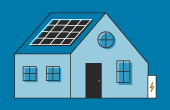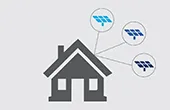In this week’s Solar News Roundup, renewables replace coal generation in New England, and research from GTM suggests solar will move below natural gas on a cost basis by 2023.
Continue readingAn overview of power optimizers
To convert the direct current (DC) electricity generated by your solar panels into usable alternating current (AC) electricity for your appliances, you’ll need an inverter. There are multiple inverter options to consider when selecting solar equipment for your system. In this article, we’ll discuss the ins and outs of power optimizers, a popular module-level power electronic (MLPE) often paired with string inverters.
Continue readingString inverters: what you need to know
Inverters are an essential part of any solar panel system – they convert direct current (DC) electricity produced by your solar panels into usable alternating current (AC) electricity. There are a few different types of inverter technologies to consider. String inverters are a tried-and-true inverter technology, and one of the oldest options available in the market today.
Continue readingBlueWave’s FlexRate loan: the complete review
(Note: As of fall 2019, BlueWave no longer offers residential solar financing.)
Solar loans are an increasingly popular option for people interested in financing their solar panel systems. The trend away from leases and towards an ownership model like solar loans is a result of two key factors: the economic benefits and incentives available to solar customers and the greater accessibility of solar loan options.
Continue readingVirtual net metering: What is It? How does it Work?
As community solar gains more attention in the U.S., more and more homeowners are hearing about a solar incentive referred to as “virtual net metering.” Thus, the question everyone is asking is fairly obvious: what exactly is virtual net metering, and how does it work? We’ve got the explanation.
Continue readingBest solar inverters review: SolarEdge vs. Enphase vs. SMA vs. Tigo
If you want to maximize your solar energy system’s production, finding the best solar inverter is as important as the solar panels you choose. For an “uncomplicated” roof – one that faces south and has no gables, chimneys, or other obstructions that can cast a shadow – the best solar inverter for you may be a standard string inverter. At the same time, more than half of new residential solar installations are using module-level power electronics (MLPEs)–such as power optimizers and microinverters–to maximize electricity production on more complicated, less ideal rooftops.
Continue readingSolar thermal energy: what you need to know
There are two key methods for harnessing the power of the sun: either by generating electricity directly using solar photovoltaic (PV) panels or generating heat through solar thermal technologies. While the two types of solar energy are similar, they differ in their costs, benefits, and applications.
Continue readingSolar news: May 3rd, 2019
In this week’s Solar News roundup, renewable energy is set to outproduce coal for the first time in April and May, and Tesla begins offering solar panel installations below market averages.
Continue readingHow to make money with SolarCity Ambassador and other rewards programs
Solar adoption is skyrocketing in the United States. Partly responsible for this surging uptake is one of the oldest industry drivers: word of mouth marketing. The SolarCity Ambassador Program, EnergySage Rewards Program, and others are a big part of this growth.
Continue readingAlternative Energy Certificates (AECs): a Massachusetts thermal energy incentive
Massachusetts homeowners experience some of the highest energy bills throughout the country; cold winters and humid summers lead to expensive heating and air conditioning costs. This has many Bay Staters looking towards clean heating technologies – such as solar hot water systems or air source heat pumps – as a way to curb these costs.
Continue reading




